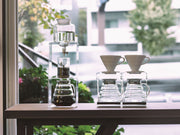Manual Coffee Brewing Methods: Make the Best Coffee at Home
Updated for 2021. Coffee is so unique. In not so many words, we take the seeds of a fruit, clean them, and then roast them. The coffee industry has become overwhelmed with a lot of noise, most of it really quite good. Local coffee shops, global brands, espresso machines you can use at home, and a plethora of beans of different roasts, origins, and flavor notes to choose from are all a regular part of our coffee-loving world.
Though, we shouldn’t forget about the connection we can have with our coffee. Some of us need a machine that can do everything for us, saving precious minutes in the morning while still providing cafe-quality espresso.
On the other hand, some might value their coffee preparation as a great use of their time. Disconnecting from the world of whirring machines and busy cafes to make a real effort into preparing coffee can be just as rewarding as making a home-cooked meal or building something on your own.
A Manual Coffee Maker is for the person who is ready to put themselves into the process and make some of the best coffee they have ever had.

The Complete Guide to Coffee Makers
There are many methods of making coffee manually, typically these processes are surprisingly different than what we are used to seeing. You shouldn’t be intimidated by manual processes though, as everything from vacuum-siphoning, pour-over, french press, and stovetop methods of making espresso and coffee still include the most important things: coffee grounds and hot water!
Grinding and brewing coffee manually takes patience and experimentation, but it can be incredibly rewarding as an artistic endeavor that leads to incredible drinks.

The Complete Guide to Coffee Grinders
A quick side note: all of these methods are essentially wireless and may require you to pour hot water into the brewer itself. We recommend using a Gooseneck Kettle with some of these methods for much more control over your pour, which can be crucial to making a good cup of coffee.
Pour Over Coffee
Speaking of pouring, a very popular and low-cost process for manual coffee is the pour over method. Pour-over is more about perfecting technique than buying expensive equipment, so those who want to take the time to learn this rising brewing method should consider this as a top choice.
In essence, pour-over is all about attention to detail and timing. The process consists of pouring hot water over your coffee grounds in a small, specially designed glass carafe with a unique coffee filter, which then drips a full-bodied coffee into the bottom of the carafe.
This is just a bit of shortened summation of a really intricate process that involves careful measurements, multiple pourings, stirring, and time management that rewards with a flavorful coffee.

How to Make Pour Over Coffee: The Complete Beginner's Guide
Vacuum Siphon Coffee
Vacuum Siphon coffee is one of the world's oldest brewing methods, said to be enjoyed since 1830. It is another process that is a relatively inexpensive way to make a unique, bold cup of coffee without having to use a lot of power.
At its core, you’ll be brewing with two glasses that stack onto one another, the top glass featuring a specially designed filter and siphon tube. To be brief, the process involves lighting a burner beneath the bottom glass to boil water, which then rises to the top container. Here you will lower the heat and stir in your coffee grounds.
After your grounds have been steeped and you’ve stirred multiple times, you’ll cut the heat completely. This causes the coffee to pour back to the bottom glass, leaving the used grounds behind thanks to the filter mentioned earlier.
French Press
The French Press was conceptualized in the 1800s with a fully functional model developed in the 1900s, well after the vacuum pot was made popular.
Many experts in the coffee industry consider French press coffee the best "regular" coffee you can get: the design and process for brewing French Press creates a smooth and full-bodied coffee that keeps french press lovers coming back. The brewing device uses metal and nylon filters which allows the larger flavors to carry colloids and lipids to pass through. Paper filters normally block these particles and they never make their way to the water.
These additional molecules create a very well-rounded cup of coffee and a unique mouthfeel that is fairly heavy and nearly syrupy. In addition to this, the user has control of the extraction or steeping time, which gives you endless control over the strength of the final product.

How to Use a French Press
Moka Pot
The Moka Pot, also known as stovetop espresso, works similarly to Siphon brewers; it’s prepared using a heating element, in this case, a stovetop, and boiling water in the pot and creates pressure through the coffee grounds to produce a creamy pot of espresso-like coffee.
We say “espresso-like” because there’s been a lot of talk about whether or not Moka Pots can actually make espresso. More modern espresso machines are made to create a certain amount of pressure on coffee grounds in order to produce a concentrated cup of espresso unlike a typical coffee maker or traditional drip coffee.
Although Moka Pots do create pressure while brewing the coffee, we’re still unsure whether or not we would consider the final result to be a “true espresso”. Whatever the results are, however, we can’t deny how incredibly delicious the coffee is. The Moka Pot has been a staple and highlight of traditional coffee in Italy and still earns a spot among the very best coffee makers in the industry.
Making Manual Espresso with ROK
Making manual espresso is another quiet process for making exceptionally good drinks, and unlike these former methods, you will be making concentrated espresso-like you would in a high-end machine.
The ROK Manual Espresso Maker has been one of our favorites since it’s mentioning in GQ back in 2012, and with it’s paired manual grinder and some dabbling, you can make really excellent espresso. The grinder itself is quite easy to use by simply cranking it’s vertical lever to manually grind beans.
Grind size can be adjusted through an adjustable gear on the bottom and can be used as a stepped or stepless grinder, depending on your preference. In any case, you can expect to grind your coffee for course, drip-style coffee grounds all the way to a super-fine Turkish coffee consistency.

A Brief History of Turkish Coffee
ROK’s Manual Espresso Maker is just as simple. Put your freshly-ground coffee and hot water into the top chamber, and bring the arms down to watch the espresso flow. You’ll want to gently bring down the arms for the first three seconds to get a nice pre-infusion before pressing the metal handles all the way down to get the espresso moving. The ROK, in good hands, can produce a great espresso that prioritizes flavor.
Best Manual Coffee Makers
If reading about the history and art of brewing coffee manually makes you want to dabble in french press, pour-over, Moka pot, or siphon coffee. Lucky for you, we partner with the most notable brands and feature a variety of manual coffee makers across our site. Here are our best manual coffee makers:

$184.99

$34.99
Is it for You?
If you or a loved one are the type of person who loves to experiment and spend quality time honing coffee skills, it may be time to consider making coffee manually. The process can be incredibly rewarding, it gives you new skills, and can result in some great drinks made with your own two hands!



